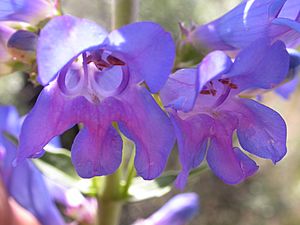Blue penstemon facts for kids
Quick facts for kids Blue penstemon |
|
|---|---|
 |
|
| Conservation status | |
| Scientific classification | |
| Genus: |
Penstemon
|
| Species: |
cyaneus
|
Penstemon cyaneus is a beautiful flowering plant often called blue penstemon or dark-blue beardtongue. It belongs to the plantain family. This plant grows naturally across the western parts of the United States. You can find it widely in states like Idaho, Montana, and Wyoming.
Contents
Discovering Blue Penstemon
The blue penstemon is a type of perennial plant. This means it lives for more than two years. It's also a subshrub, which means it has a woody base but isn't as big as a full shrub. Its stems grow straight up, reaching about 70 centimeters (about 2.3 feet) tall.
What Does It Look Like?
Most of the leaves of the blue penstemon grow near the bottom of the plant. These leaves can be up to 15 centimeters (about 6 inches) long. They have small stalks called petioles that connect them to the stem. Higher up on the stem, you'll find smaller leaves that wrap around the stem at their base.
The flowers are a lovely blue color. Sometimes, they might even have a hint of pink. Each flower is about 3.5 centimeters (1.4 inches) long. They are about 1 centimeter (0.4 inches) wide at their opening. These bright flowers are very popular with bees, which help the plant make seeds.
Where Does It Grow?
This tough plant likes to grow in open, high areas. You can often spot it on high plains. It also thrives in areas with lots of sagebrush, which is a common plant in the western United States. It prefers dry conditions.
Why Is It Important?
The blue penstemon is useful for several reasons. It can be planted in revegetation projects. These projects help bring back natural plants to areas where they have been lost. This is great for wildlife habitats.
It's also a good choice for landscaping in dry places. For example, it can be planted along roadsides where there isn't much water. However, it can be a bit tricky to grow sometimes. This is because it can get sick from root rot infections. Root rot is a disease that damages the plant's roots.


